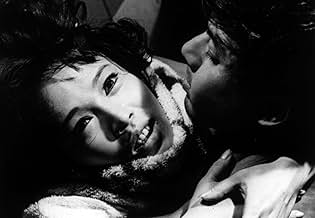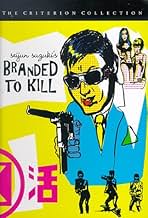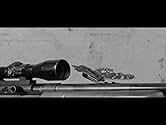IMDb रेटिंग
7.2/10
11 हज़ार
आपकी रेटिंग
अपनी भाषा में प्लॉट जोड़ेंAfter a botched assignment, a rice-fetishizing hitman finds himself in conflict with his organization, and one mysterious, dangerous fellow-hitman in particular.After a botched assignment, a rice-fetishizing hitman finds himself in conflict with his organization, and one mysterious, dangerous fellow-hitman in particular.After a botched assignment, a rice-fetishizing hitman finds himself in conflict with his organization, and one mysterious, dangerous fellow-hitman in particular.
- पुरस्कार
- कुल 1 जीत
Jô Shishido
- Gorô Hanada
- (as Joe Shishido)
Annu Mari
- Misako Nakajô
- (as Anne Mari)
Akira Hisamatsu
- Ophthalmologist
- (as Kôsuke Hisamatsu)
Kôji Seyama
- Restaurant Guest
- (as Takashi Seyama)
फ़ीचर्ड समीक्षाएं
Wow, I thought the Japanese turned out some weird stuff nowadays. That lame crap has nothing on this wacky thing, which requires about 57 viewings to make any kind of narrative sense.
Jo Shishido (who has cheek implants (!!) that make him look like a chipmunk) is the third best killer in Japan. Apparently, all assassins in Japan do, other than kill people, is try to better themselves in the rankings. It's much like Pokemon, in a way. Jo strives to be number one, but, not only does he have to get past a bunch of backstabbers, he has to find the #1 Phantom, the high man on the totem. And when he does, it's rip roarin' nonsense time!
It's hard to tell if this is a work of genius or of pure insanity. There's no real narrative; more like a bunch of scenes held together by the fact they're all in the same movie. Some of the stuff is so nutty, it's hard not to call it brilliant, like when Jo finally does meet Phantom and they have a sit-down, Phantom pisses his pants rather than get up and take his eyes off Jo. Or the hit that gets foiled by a butterfly. Or Jo's girlfriend's obsession with dead bugs, which lay in piles on the floor. Or the shocking amount of sex and violence in a movie made in 1967. It's really no surprise that the director had his contract summarily terminated when the studio watched this: it is the weirdest movie to come out of Japan in 1967. Or maybe ever. Be prepared to watch more than once.
Jo Shishido (who has cheek implants (!!) that make him look like a chipmunk) is the third best killer in Japan. Apparently, all assassins in Japan do, other than kill people, is try to better themselves in the rankings. It's much like Pokemon, in a way. Jo strives to be number one, but, not only does he have to get past a bunch of backstabbers, he has to find the #1 Phantom, the high man on the totem. And when he does, it's rip roarin' nonsense time!
It's hard to tell if this is a work of genius or of pure insanity. There's no real narrative; more like a bunch of scenes held together by the fact they're all in the same movie. Some of the stuff is so nutty, it's hard not to call it brilliant, like when Jo finally does meet Phantom and they have a sit-down, Phantom pisses his pants rather than get up and take his eyes off Jo. Or the hit that gets foiled by a butterfly. Or Jo's girlfriend's obsession with dead bugs, which lay in piles on the floor. Or the shocking amount of sex and violence in a movie made in 1967. It's really no surprise that the director had his contract summarily terminated when the studio watched this: it is the weirdest movie to come out of Japan in 1967. Or maybe ever. Be prepared to watch more than once.
Rice-sniffing, #3 Killer, dead butterflies, snuff films. Where to start? 'Koroshi no rakuin' is a surreal, Kafkaesque, timewarp of a film masquerading as a stylish 60's hit-man movie. Nikkatsu Studios fired Seijun Suzuki over this film's "incomprehensibility."
Suzuki is an auteur of the highest magnitude, nobody has ever used a widescreen, black and white, "Nikkatsu Scope" frame quite like him. The dense and beautifully chaotic images are overwhelming on your first viewing, it's the sort of movie that shows you something new every time you watch it.
Essentially Hanado Goro (Jo Shisido) is the yakuza's #3 Killer, but he desperately wants to be #1. As might be expected, being a hired gun is a stressful life and Hanado takes the edge off with lots of sex and the smell of boiling rice. The sex gets him embroiled in some sort of a plot and he finds himself getting much better acquainted with #1 Killer than he'd ever wanted to be.
Time backs up, swirls around, restarts, slows down. Major themes include, but are not limited to: ambition, lust, rivalry, bureaucracy, addiction, loss of self-control. There's a certain parallel in that with this picture Suzuki derailed his own career as a "salary man" making Nikkatsu yakuza flicks, many of Hanado's thoughts and impulses must have been the director's own.
Suzuki is an auteur of the highest magnitude, nobody has ever used a widescreen, black and white, "Nikkatsu Scope" frame quite like him. The dense and beautifully chaotic images are overwhelming on your first viewing, it's the sort of movie that shows you something new every time you watch it.
Essentially Hanado Goro (Jo Shisido) is the yakuza's #3 Killer, but he desperately wants to be #1. As might be expected, being a hired gun is a stressful life and Hanado takes the edge off with lots of sex and the smell of boiling rice. The sex gets him embroiled in some sort of a plot and he finds himself getting much better acquainted with #1 Killer than he'd ever wanted to be.
Time backs up, swirls around, restarts, slows down. Major themes include, but are not limited to: ambition, lust, rivalry, bureaucracy, addiction, loss of self-control. There's a certain parallel in that with this picture Suzuki derailed his own career as a "salary man" making Nikkatsu yakuza flicks, many of Hanado's thoughts and impulses must have been the director's own.
Much has been made of how weird and off-beat Branded to Kill is. However it is important to consider it as part of Suzuki's progression through film-making. Before you can break the rules, you have to master them. Suzuki did so in several of his earlier pictures, from Underworld Beauty to Tattooed Life. And every time he was called to deliver a run of the mill yakuza flick, he infused it with his personal style. More and more he fractured the visual language of cinema every time, until he got rid of it or transformed it into a psychotic beast for Branded to Kill, revealing what lies beneath.
A plot synopsis would read something like this: Jo Shishido is killer Number #3 with ambitions of becoming Number #1. Who is Number #1? Does he even exist? That is until he's called to transport a client safely. The borders between realism and surrealism blur hopelessly at that point and what follows is a nightmarish concoction of beautiful set-pieces that lead up to his final confrontation with Number #1.
Saying that Branded to Kill is weird is an understatement. In turns fascinating, confusing, nonsensical, surrealist, psychotic, thrilling, poetic, nightmarish, confusing, tiring, mind-numbing and exhilarating, it defies description as much as it defies sense. The boundaries of time, space and logic are blurred and all you can do is experience the ride. It doesn't try to make much sense and apparently Suzuki made it up as he went along. The result was to be fired by Nikkatsu Studios for delivering a picture that "made no sense". I don't blame them really. Studios are businesses and Branded to Kill is not a movie with massive appeal. Ahead of its time in that aspect.
Filmed in beautiful black and white, with a languid jazzy score and a film-noir ambiance, Branded to Kill will certainly appeal to people with strange tastes. Don't go in expecting a yakuza action flick (although there are several gunfights and enough action to go along) or you'll be sorely disappointed. As an indication of the uncharted territories Branded to Kill's treads, I'll guesstimate that fans of Eraserhead-era Lynch, Koji Wakamatsu and Singapore Sling's style will appreciate it. I can't say "like it", because ultimately that's between the viewer and Branded to Kill to sort. Either way, it has to be experienced at least once. Just sit back and let the surreal absurdity of it all wash over you...
A plot synopsis would read something like this: Jo Shishido is killer Number #3 with ambitions of becoming Number #1. Who is Number #1? Does he even exist? That is until he's called to transport a client safely. The borders between realism and surrealism blur hopelessly at that point and what follows is a nightmarish concoction of beautiful set-pieces that lead up to his final confrontation with Number #1.
Saying that Branded to Kill is weird is an understatement. In turns fascinating, confusing, nonsensical, surrealist, psychotic, thrilling, poetic, nightmarish, confusing, tiring, mind-numbing and exhilarating, it defies description as much as it defies sense. The boundaries of time, space and logic are blurred and all you can do is experience the ride. It doesn't try to make much sense and apparently Suzuki made it up as he went along. The result was to be fired by Nikkatsu Studios for delivering a picture that "made no sense". I don't blame them really. Studios are businesses and Branded to Kill is not a movie with massive appeal. Ahead of its time in that aspect.
Filmed in beautiful black and white, with a languid jazzy score and a film-noir ambiance, Branded to Kill will certainly appeal to people with strange tastes. Don't go in expecting a yakuza action flick (although there are several gunfights and enough action to go along) or you'll be sorely disappointed. As an indication of the uncharted territories Branded to Kill's treads, I'll guesstimate that fans of Eraserhead-era Lynch, Koji Wakamatsu and Singapore Sling's style will appreciate it. I can't say "like it", because ultimately that's between the viewer and Branded to Kill to sort. Either way, it has to be experienced at least once. Just sit back and let the surreal absurdity of it all wash over you...
Man, why are those late 60's / early 70's criminal movies so fantastically good? I guess it must have something to do with those old saturated film stocks. If only Kodachrome would muster the courage to bring back what brought us the those classics: Dirty Harry, Bullitt, The Getaway etc.
Or then again, maybe it was just the period in which these movies were made. The hippie era did, as it would appears produced a surprisingly good number of film titles. Comparatively, Branded to Kill reminds one distinctively in style to John Boorman's film of the same year, POINT BLANK, both in choice of film stock and composition of photography, but aside from this the films are completely different. Branded to Kill tells the story of a yakuza hitman (with a penchant for fast woman and inhaling "rice steam") who seeks the desirable title of #1 gunman. But of course, it's not going to be that easy...
Or then again, maybe it was just the period in which these movies were made. The hippie era did, as it would appears produced a surprisingly good number of film titles. Comparatively, Branded to Kill reminds one distinctively in style to John Boorman's film of the same year, POINT BLANK, both in choice of film stock and composition of photography, but aside from this the films are completely different. Branded to Kill tells the story of a yakuza hitman (with a penchant for fast woman and inhaling "rice steam") who seeks the desirable title of #1 gunman. But of course, it's not going to be that easy...
Seijun Suzuki refers to his films as "entertainment" and without critical merit. Yet, this was somewhat tongue in cheek as he stated that critics feel a movie must have a "moral or some social commentary" to be worthy of attention. Be that as it may, "Branded to Kill" is simply a fantastic achievement. Suzuki was working with both a lead man and a script provided to him by the Nikkatsu Corporation. As such, when you evaluate his films, you do so by focusing on the technical merits. Personally, I find his disconnected editing, and surreal lighting styles to be amazing. Suzuki's skill turns what is otherwise a laughable boiler plate film noir into something more. The lighting and editing make the exclamations that the script doesn't, and the decision to shoot the final scene in a boxing ring is brilliant.
It was entertaining to watch person after person jump up and down about the originality of "Ghost Dog" with no mention of the fact that Jarmusch lifted one of the assassination sequences unchanged from "Branded to Kill". Hopefully as more of Suzuki's work comes to DVD, people and critics alike will recognize a blatant tribute when it is given. Suzuki deserves them all.
It was entertaining to watch person after person jump up and down about the originality of "Ghost Dog" with no mention of the fact that Jarmusch lifted one of the assassination sequences unchanged from "Branded to Kill". Hopefully as more of Suzuki's work comes to DVD, people and critics alike will recognize a blatant tribute when it is given. Suzuki deserves them all.
क्या आपको पता है
- ट्रिवियाWhen Nikkatsu studio executives saw the finished product, they thought it was too terrible to be released, so they shelved it. Seijun Suzuki along with others in the film business, film critics, and students protested in unfairness since, by contract, Nikkatsu was supposed to release the finished film theatrically. It went to court, with a ruling in favor of the director. Nikkatsu had to pay for damages and have the film released. Suzuki's contract with Nikkatsu was terminated, and with the bad reputation, was unable to work on a feature film for the next 10 years.
- भाव
Misako Nakajô: My dream is to die.
- कनेक्शनFeatured in Seijun Suzuki | TCM (2013)
- साउंडट्रैकKoroshi no buruusu (Killing Blues)
Lyrics by Hachiro Guryu (Yasuaki Hangai, Takeo Kimura, Yutaka Okada, Chûsei Sone, Seijun Suzuki, Yôzô Tanaka, Seiichiro Yamaguchi and Atsushi Yamatoya)
Music by Kagehisa Kusui
Sung by Atsushi Yamatoya
टॉप पसंद
रेटिंग देने के लिए साइन-इन करें और वैयक्तिकृत सुझावों के लिए वॉचलिस्ट करें
- How long is Branded to Kill?Alexa द्वारा संचालित
विवरण
- चलने की अवधि1 घंटा 31 मिनट
- रंग
- पक्ष अनुपात
- 2.35 : 1
इस पेज में योगदान दें
किसी बदलाव का सुझाव दें या अनुपलब्ध कॉन्टेंट जोड़ें

























